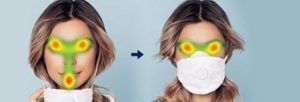
According to Herta, one of the key technologies that will help make the post-Covid19 world a safer place is face recognition. In June 2020, and mid pandemic, the company improved its facial recognition algorithms to adapt to the new normality, launching a new software that allows the identification of faces wearing a mask, with an algorithm that gives priority to the upper part of the face rather than its totality.
Herta recognises that in general people can sometimes be afraid of being exposed to face recognition systems, in the belief that they are a part of some kind of malicious Orwellian style conspiracy. However, Herta argues the exact opposite, in that they are offering much needed real-life solutions with highly accurate biometric technology that allows – among other applications- touchless and distant access control to workplaces, critical infrastructures, transports or events.
With face recognition, there is no need to manipulate access security cards, to approach or put a finger in any device shared by hundreds of other people, thus helping to control pandemic spread.
However, there is now also a new major challenge for face recognition technology in this new normality: the common use of medical masks that occlude half of the face. Ideally, individuals should not have to expose themselves and others to the virus by removing their masks for access control purposes, but still most current face recognition algorithms are not yet sufficiently robust to deal with such large facial occlusions.
Indeed, we humans are facing the same challenge. Eye-tracking and psychological works have widely studied the human visual attention mechanisms that take place when confronted with the task of identifying people, according to a scientific paper presented by the National Center for Biotechnology Information in Maryland, USA. The research demonstrates that we innately and systematically fix on the triangular face region formed by the two eyes and the mouth. Therefore, if a vertex of this triangle is occluded by a mask, our long-term acquired face recognition mechanisms will encounter difficulties, lose robustness, and take time to adapt to the new facial configuration. Like humans, face recognition algorithms have also needed to adapt themselves to the structure of masked faces.
Generally speaking, existing face recognition algorithms are grounded on artificial intelligence (AI), particularly on machine learning and deep learning techniques. This means that they automatically learn an identification strategy from a dataset of millions of facial images used for their training. Until now, facial training datasets have varied in terms of illumination conditions, head poses or backgrounds; they have also presented certain facial occlusions in the form of eyeglasses, caps, scarves or beards. But they hardly ever have contained faces with medical masks.
A possible solution to make face recognition models able to identify persons with masks consists of collecting new training images for that purpose. But there are other, more algorithmic-oriented, alternative approaches. Recently, according to Herta, state-of-the-art academic papers have introduced visual attention mechanisms for deep neural networks, so that they can be taught to focus their attention on specific regions of the image during training.
Herta suggests that these mechanisms could be applied to teach face recognition models to shift their attention towards the unmasked upper-face region. In any case, in the Spring of 2020 it was apparent that face recognition systems need to be able to recognise both mask wearers and unmasked people. Therefore, identifying another interesting way to approach the problem could be by building a mask detection facility and then, depending on whether the mask is present or not, applying different adapted face recognition strategies.
Herta worked tirelessly and quickly on these occlusions over several months with the result that, in June 2020 the company introduced what it has termed as a “new normality” era for facial recognition, with software that recognises a mask wearer and an algorithm that gives priority to the upper part of the face.











